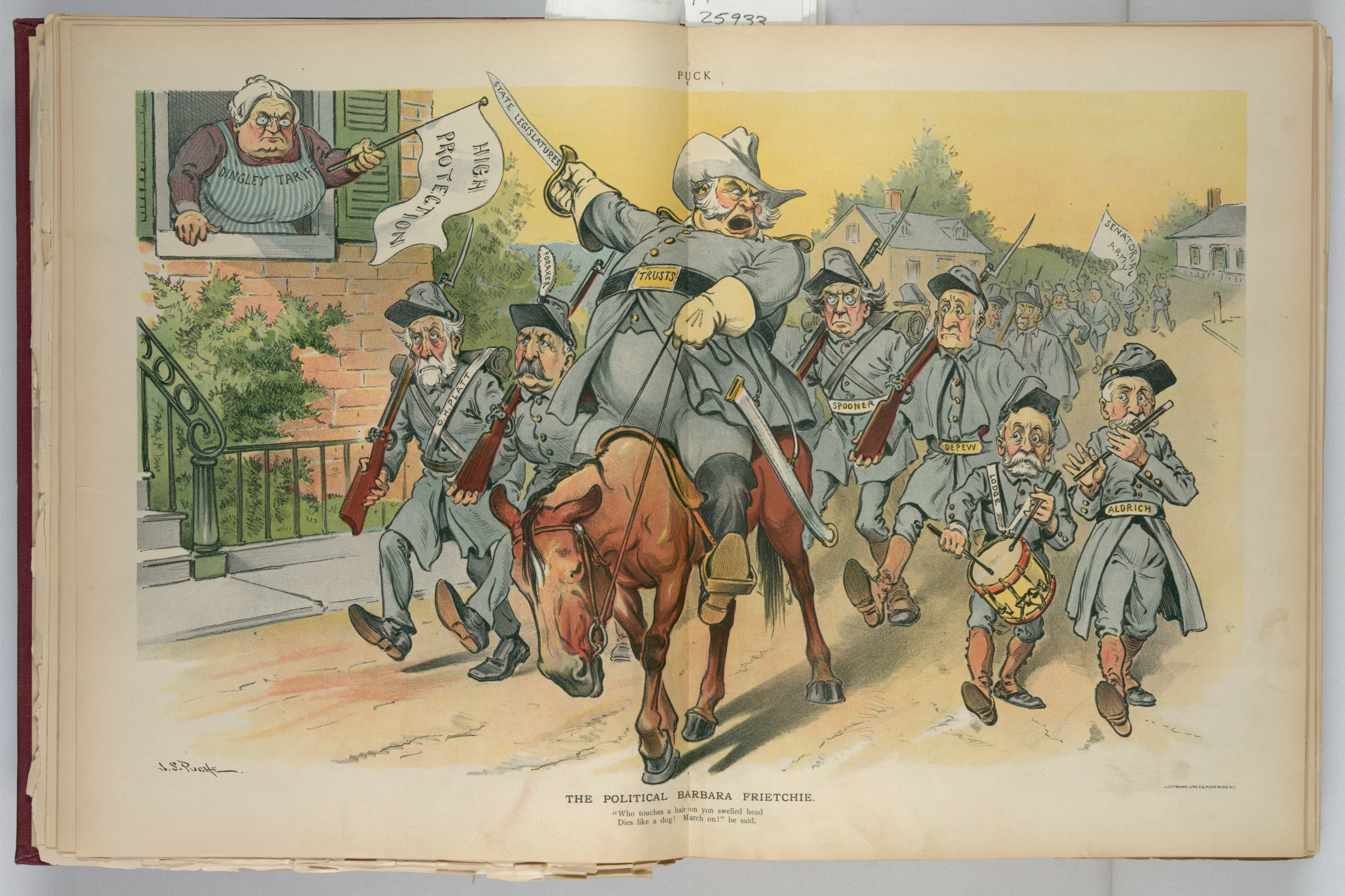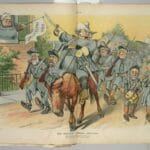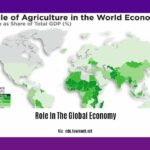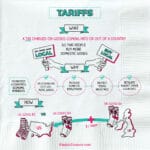Imagine stepping back in time to the late 1800s when a major economic event shook America: the Dingley Tariff. Like a mighty storm, it aimed to protect American businesses from foreign competition and boost the nation’s economy. Over a hundred years later, we’re still talking about it, exploring how it changed industries, made some folks happy and others not so much, and left a lasting mark on the way we think about trade and government’s role in our economy.
Dingley Tariff Act Impact: A Century of Repercussions
Let’s journey back to 1897 – a time of handlebar mustaches, burgeoning industry, and the enactment of the Dingley Tariff. Passed under President William McKinley, this legislation significantly altered American trade, and its impact is still debated over a century later.
The Dingley Tariff imposed some of the highest taxes in U.S. history on imported goods – an average of 52%! Suddenly, everyday items like sugar, warm woolly clothes, and factory-made goods became significantly more expensive. This benefited American industries shielded from foreign competition, but everyday Americans felt the pinch in their wallets.
But the Dingley Tariff’s impact extended far beyond its initial blow to consumer pocketbooks. It likely played a role in the acceleration of giant corporations merging into powerful trusts and monopolies, controlling entire industries. This, of course, ignited fierce debate about the role of government in regulating big business and ensuring fair competition.
The tariff also sparked a broader discussion about the delicate balance between protecting American jobs and industries versus embracing free trade for potentially lower prices. It’s a debate that continues to rage today, albeit with different players and products.
Even though it’s been over a century since its enactment, the Dingley Tariff serves as a cautionary tale, a reminder that economic policies can have unintended consequences. It compels us to grapple with the complex trade-offs inherent in protecting domestic interests while navigating the global marketplace. The Dingley Tariff’s legacy is a testament to the enduring impact of trade policies on the intricate tapestry of American economic and political life.
Unpacking the Dingley Tariff Act: Winners, Losers & Lasting Impact
The Dingley Tariff Act of 1897, enacted during President William McKinley’s term, dramatically altered how America approached trade. Imagine a law that suddenly made goods from other countries significantly more expensive – that’s what the Dingley Tariff Act did.
It imposed an average increase of 52% on imported goods, which essentially gave American companies a substantial advantage in the market. This move, while potentially leading to cheaper goods for Americans in theory, didn’t quite work out that way. While this move helped out some American businesses, especially those in manufacturing, it also meant that everyday items started costing more for regular folks.
Consider this: if a company knows people will likely buy their product because it’s cheaper than the foreign alternative, there’s less incentive to keep prices low. So, while jobs were created as businesses were booming, people were also feeling the pinch on their wallets.
This law wasn’t without its critics. Some believed it went too far, arguing that it stifled competition and paved the way for enormous companies to dominate the market, almost like monopolies. Conversely, supporters praised its role in bolstering American industries.
The Dingley Tariff Act, even though it was enacted over a century ago, still sparks debate. It reminds us that finding the right balance between protecting our own businesses and staying open to global trade is a conversation that’s far from over.
Deconstructing the Walker Tariff: A Free Trade Experiment
The Walker Tariff of 1846 marked a significant shift in U.S. trade policy. Before this, the United States predominantly embraced protectionist trade policies – essentially trying to protect American industries by making foreign goods more expensive. However, the Walker Tariff went in the opposite direction, slashing those tariffs and ushering in a period of freer trade that lasted for a considerable time.
Like most major changes, the Walker Tariff brought both advantages and disadvantages.
One of the notable benefits of the Walker Tariff was that it seemed to invigorate trade, especially since it coincided with Great Britain relaxing its own trade restrictions. This resulted in increased goods flowing back and forth across the Atlantic, which was positive for business.
Surprisingly, even though the government collected less money per imported item, the total revenue from tariffs actually increased! This suggests that the lower prices encouraged people to buy more, which boosted the economy and, consequently, government coffers.
The lower tariffs, particularly on iron, also fueled a wave of railroad construction in the 1850s. This exemplified how freer trade could significantly stimulate industry.
However, not everyone was celebrating. The South, heavily reliant on exporting cotton, harbored concerns. While the overall U.S. economy seemed to flourish, some historians argue that the Walker Tariff might have made the South more vulnerable to the fluctuations of global prices. The extent to which the South was impacted remains a topic of debate among historians today.
In essence, the Walker Tariff was a mixed bag. It undoubtedly brought significant change, leading to increased trade, increased government revenue, and a boost for industries like railroads. However, it also likely left the South feeling uncertain about its place in this new era of freer trade.
The McKinley Tariff: Economic Boon or Burden for Americans?
The McKinley Tariff, enacted in 1890, caused significant upheaval in the U.S. The goal was to give American industries an advantage by imposing steep taxes on goods imported from other countries. Sounds straightforward, right? However, the situation was far more intricate, resembling a chain reaction with ripples spreading out in all directions.
On the one hand, certain industries, like tinplate manufacturers (that shiny material used for cans and other items), were quite content. They saw an opportunity to expand their businesses and hire more workers, and the tariff appeared to be their ticket to success. Additionally, the government benefited as well. All those extra taxes meant increased revenue flowing into their coffers, which they could then allocate to public projects and other initiatives.
However, there was a downside to these benefits. Remember those higher taxes on imported goods? They ended up directly impacting regular Americans through increased prices. Suddenly, everyday items, whether produced domestically or shipped from overseas, became more expensive, and people were not pleased. This led to considerable discontent and even a political backlash, with the Republicans facing the brunt of it and losing seats in the 1890 midterm elections.
Moreover, other countries weren’t going to accept this passively. They perceived the McKinley Tariff as an affront and retaliated with their own tariffs on American goods. This trade war likely disrupted our exports and threw a wrench into the global trade system.
The situation with sugar presents a particularly interesting case. The government believed they were supporting the American sugar industry by eliminating tariffs on sugar imports from places like Hawaii. The intention was to make their sugar cheaper in the U.S. However, the sugar producers in Hawaii saw this and realized that becoming part of the U.S. would mean avoiding these tariffs altogether! And that, in part, is how the McKinley Tariff contributed to Hawaii’s eventual annexation by the United States. Talk about unintended consequences!
The legacy of the McKinley Tariff is complex and multifaceted. It serves as a prime example of how attempting to manipulate the economy can create both winners and losers. It also ignited a debate about protectionism versus free trade that persists to this day. Should governments intervene in the market to protect their own industries, or should they allow the free market to operate freely? These are questions that economists and policymakers are still grappling with today.
The McKinley Tariff was undoubtedly a significant event, leaving its mark on American history in ways that are still felt and debated today. It demonstrates that even the most well-intentioned policies can have unforeseen consequences and that economics is rarely a simple matter of right and wrong.
The High Cost of Protection: How Tariffs Impact Consumers (Then and Now)
Tariffs, those seemingly simple taxes levied on imported goods, have been a cornerstone of economic policy for centuries. Intended to protect domestic industries and generate revenue, their impact often extends far beyond the initial target, profoundly affecting consumers, businesses, and international relations.
The Dingley Tariff of 1897 stands as a stark example of the far-reaching consequences of protectionist policies. Enacted during President William McKinley’s term, the Dingley Tariff imposed some of the highest duties in U.S. history, averaging a staggering 57% on imported goods. While designed to bolster American industries, the immediate impact on consumers was undeniable: The cost of living surged by nearly 25% between 1897 and 1907.
While proponents argued that the tariff’s protectionist measures fostered domestic industry growth and job creation, critics contended that these benefits came at a steep price for consumers. The increased cost of imported goods rippled through the economy, driving up prices for everyday items and straining household budgets, particularly for working-class families.
The Dingley Tariff ignited a firestorm of debate about the role of government intervention in the economy and the delicate balance between protecting domestic interests and fostering free trade.
Want to learn more about the infamous Spanish Inquisition? Explore our Spanish Inquisition crossword puzzle and test your knowledge of this captivating historical event. Discover the exact location of the infamous Weehawken Dueling Grounds by accessing our detailed information on the Weehawken Dueling Grounds address. Immerse yourself in the history of California’s notorious Folsom State Prison with our captivating Folsom State Prison photos gallery. Take a virtual tour of the Canajoharie Academy in 1846 and uncover the rich history of this educational institution. Finally, plan your next getaway and uncover the hidden gem of Ho Chi Minh Trail beach access.
- Unlock Water’s Symbolism: A Cross-Cultural Exploration - April 20, 2025
- Identify Black and White Snakes: Venomous or Harmless? - April 20, 2025
- Unlocking Potential: Origins High School’s NYC Story - April 20, 2025















